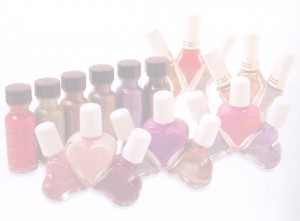Colour
Contents

There are two main ways of achieving coloured nails: applying polish to your own nails, or getting artificial nails. Each of these is involved enough to warrant its own section. We’ll start with the cheapest, easiest and best for your nails:
Nail Polish
This comes in thousands of colours. I know one girl who has 276 shades of nail polish – all different. There is a vast range in prices, too, from $2.99 clearance specials to $25.00 designer hues. Pick a price you can afford, or it won’t be any fun.
There’s a range in quality, but not as great as you might expect. Cheaper brands have a bit less pigment in them and so require an extra coat or two. Between midrange and high-end polishes there’s little to choose. Designer names will sometimes offer unique colours for a season or two. The best quality polishes are found in salons; they cover well, go on smoothly, and dry fast, as professional manicurists require. You can sometimes buy them there.
Picking a colour is very much a matter of personal taste, but here are a few useful guidelines.
- If you have large hands or fingernails, you may be happier with lighter, natural tones. Brilliant or dark shades draw attention to your hands – and their size.
- Fair skinned hands can wear most colours, including mauves and greens. Darker or reddish skin works well with reds, oranges and earth tones. Black or brown skin gives a striking contrast to metallics, golds and coppers.
- Tip: take some transparent tape to the cosmetics counter with you. Stick it on your hand and test polishes on that.
- Plain, satin or pearl finishes work well for a daytime look. High-gloss and metallic looks are great for evenings. For special occasions, glitter, either in the polish or in a top coat add a special finishing touch.
While you’re at the store, remember to pick up:
- a bottle of base coat. This is clear nail polish that protects your nails from staining and gives a smooth surface for the colour.
- a bottle of top coat. This too is clear, but is especially hard and quick-drying for protection.
- Some Q-tips, for when you go outside the lines.
- Polish remover (you don’t want any weird looks at the jobsite, remember?) Check the Cleanup section at the end of this article for tips on what to pick.
Applying Polish
It’s not hard. Get everything together, give yourself lots of time and – this is crucial – make sure it’s the LAST thing you do before you go out the door. That way, there’s less to go wrong.
Tip: Put your polish in the fridge for 15 minutes. This intensifies the colour.
Check your nails for problems. Remove any old polish, push the cuticles back, get rid of hangnails, finish up any shaping and filing and so on.
Wash your hands and dry them thoroughly. Don’t use a moisturiser at this point; the nail surface must be scrupulously clean for the polish to stick properly.
Apply a thin coat of base coat to each nail. You’ll find it easiest to place the hand being polished flat on the table and rest the heel of your brush hand on the table for stability. Place a blob right near the base of the nail; then flow one stroke up the centre of the nail to the tip. Flow additional strokes alongside it to cover the nail, always starting at the base and going all the way to the tip. Get as close to the sides of the nail as possible without going over; this will give you a cleaner line. Use pressure to vary the width of the brush, not to work the product in. Large nails may require two blobs.
Let the base coat dry. Most will be dry to the touch in a couple of minutes. Don’t rush this!
Retrieve your polish from the fridge and mix it. Don’t shake the bottle; it builds up air bubbles which hasten drying out and thickening. Instead, roll the bottle between your palms until the polish is evenly and thoroughly mixed.
Apply a thin coat of polish, exactly as you did the base coat. With light or sheer colours this may be all you need.
Bolder colours may require a second or even third coat. Resist the temptation to hurry things along with a thicker coat; it ends up taking longer to dry.
Let each coat dry very thoroughly. If you don’t, the polish beneath will never dry and your beautiful nail job can be destroyed in an instant.
Wait. Don’t put on jewelry. Don’t do makeup. Don’t look for your keys. Don’t put on your coat. Don’t do ANYTHING that involves your hands. Don’t even lie around and eat bonbons. Just play the helpless female. Or you could practise your feminine wiles and try to cajole others into doing all those things for you.
Tip: Running very cold water over your nails also hastens the drying process.
When you can touch your little fingers together, nail to nail, without them sticking, you’re just about done.
A final coat of clear top coat will harden the finish and help prevent nicks, gouges and The Dreaded Divot. Top coat generally dries very fast.
Off you go!
